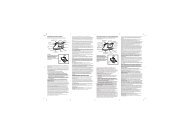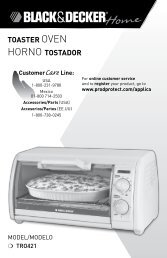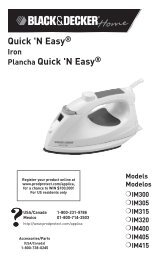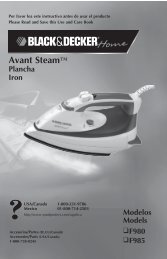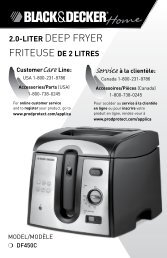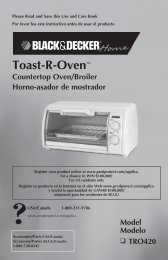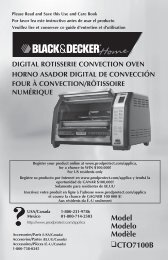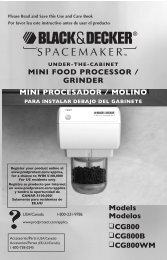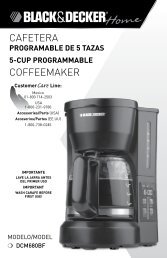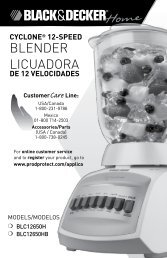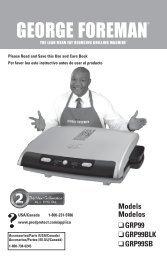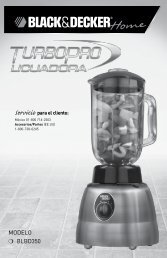TR555LC Use and Care Manual - Breadman
TR555LC Use and Care Manual - Breadman
TR555LC Use and Care Manual - Breadman
Create successful ePaper yourself
Turn your PDF publications into a flip-book with our unique Google optimized e-Paper software.
<strong>TR555LC</strong>_IB_New_31-12-02 31/12/02 11:33 AM Page 7<br />
ADDITIONAL IMPORTANT SAFEGUARDS<br />
TROUBLE SHOOTING (CONTINUED)<br />
WARNING: This appliance generates heat <strong>and</strong> escaping steam during use.<br />
<strong>Use</strong> proper precautions to prevent risk of burns, fires, or other injury to<br />
persons or damage to property.<br />
1. Always use oven mitts when h<strong>and</strong>ling hot materials <strong>and</strong> allow metal<br />
parts to cool before cleaning.<br />
2. Do not place the appliance on an unsteady or cloth-covered surface.<br />
3. Keep the appliance at least 2 inches away from walls or any other<br />
objects when using it.<br />
CAUTION: During use, the internal parts of the <strong>Breadman</strong> ® <strong>and</strong> the<br />
area around the Steam Vent <strong>and</strong> Viewing Window are HOT. Keep<br />
out of reach of children to avoid possible injury.<br />
POLARIZED PLUG<br />
This appliance has a polarized plug (one blade is wider than the other).<br />
To reduce the risk of electric shock, this plug is intended to fit into a<br />
polarized outlet only one way. If the plug does not fit fully in the outlet,<br />
reverse the plug. If it still does not fit, contact a qualified electrician. Do<br />
not attempt to modify the plug in any way.<br />
ELECTRIC POWER<br />
If the electrical circuit is overloaded with other appliances, your appliance may<br />
not operate properly. It should be operated on a separate electrical circuit from<br />
other appliances.<br />
Symptom<br />
The Bread Machine<br />
does not bake<br />
the bread<br />
Bread has an<br />
offensive odor<br />
Baked bread is soggy<br />
or the bread’s surface<br />
is sticky<br />
The Kneading<br />
Paddle was stuck<br />
in the bread<br />
The bread rose<br />
too high<br />
Possible Solutions<br />
The Dough program was selected. To bake the bread, choose<br />
the appropriate program for baking bread.<br />
Check to be sure you added the correct amount of yeast.<br />
Measure carefully — too much yeast will cause an unpleasant<br />
odor <strong>and</strong> may cause the loaf to rise too high.<br />
Be sure to use only fresh ingredients.<br />
Remove the bread from the Bread Pan as soon as it is<br />
done baking. Leaving it in the Pan allows condensation<br />
to collect on the sides touching the Pan.<br />
Also be sure to cool the loaf on a wire rack; cooling it on<br />
a countertop causes the side next to the counter to<br />
become soggy.<br />
Make sure the Kneading Paddle is mounted properly before<br />
adding ingredients to the Bread Pan <strong>and</strong> baking.<br />
Sometimes denser or crustier loaves of bread may pull the<br />
Kneading Paddle out with them when you remove the loaves<br />
after baking. When this happens, use a non-metal utensil <strong>and</strong><br />
gently remove the blade from the bottom of the loaf.<br />
Make sure not to add too much yeast, water or flour. Too<br />
much of any of these may cause the loaf to rise more than<br />
it should.<br />
The bread didn’t<br />
rise enough<br />
Did you add enough yeast, water or sweetener?<br />
Make sure to add ingredients in the proper order: liquids,<br />
dry ingredients, yeast. Make sure yeast doesn’t get wet<br />
until the <strong>Breadman</strong> ® mixes the ingredients together.<br />
NOTE: Typically, bread made with whole grain flours<br />
will not rise as high as bread made with refined<br />
flours. Make sure you are using bread flour.<br />
2<br />
27




